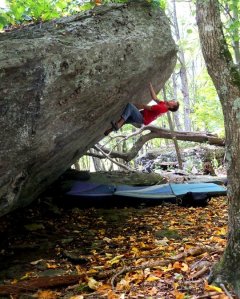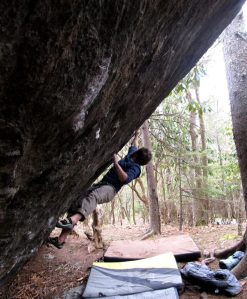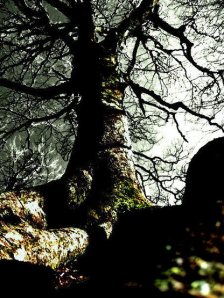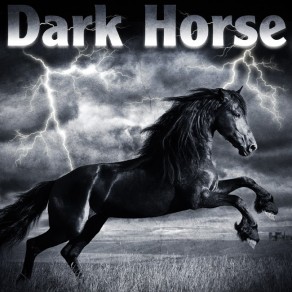
This popular and ridiculously easy-to-access problem is one you don’t want to miss out on if you haven’t climbed the line multiple times already. “Indian Outlaw”(V3) is located on the Rock House Boulder in the Picnic Area of the park. This boulder is directly beside the parking lot and the trailhead sign post for the Rock House Ridge Trail. The boulder takes its namesake due to the fact that Cherokee artifacts were found by the Rock House Boulder and it is rumored that the rock itself may have at one time served as a house or shelter. The name of the climb can be traced to Tim McGraw’s country song, “Indian Outlaw,” which found a place on the Top 10 Billboard Country Singles charts in March of 1994. Both this song and the boulder problem have some controversy. The song’s controversy being that it fairly harshly perpetuates a profusion of Native American stereotypes. The boulder problem’s controversy, by comparison, is almost not worth talking about… However, being Grayson Highlands Bouldering and all, we will cover it at some length at the end of the write up. You’re welcome.

This line works out from the initial steepness to a few edges and then up a right trending ramp. At the top of the ramp is a thin horizontal and a bigger move to a sloper, followed by a nice jug for the top out.
With the boulder being literally beside the trail, if you have never taken the entire Rock House loop trail before, its well worth your while. Virginiaoutdoors.com writes that: “Rock House Ridge Trail is a 1.4 mile, moderate difficulty loop that is accessible near the picnic area. At the trail head stands a large rock, the far side of which slants inward creating a shelter. Cherokee Indian artifacts were once found near this rock. During May and June you can find the pink lady’s slipper orchid, or moccasin flower, growing in the woods near the ‘rock house.’ The trail winds through thickets of rhododendron along a narrow path, working uphill and downhill through hardwoods and mountain laurel and, for a short distance, alongside the Wilburn Branch Trail before returning to the trail head. This trail is closed from November 1 to May 1”. While on the subject of the trail, please take caution not to obstruct Park visitors from hiking. Be mindful of your crashpads and move them if hikers are obstructed from walking by.

The trail description above is right on the money. The rhodos form awesome tunnels all along the way. Nice sweeping mountain views can be had as you hike past open fields and the terrain is mostly easy going. Also, an obscure block called the Fluids Boulder is a short distance up the trail with some funky, rarely traveled lines to try.
Do miss out on the Rock House’s other amazing, park classic problems either! These include “Ghost Dance” (V7), “Cherokee Dihedral”(V1), “Arrowhead Arete”(V3), and “Dark Horse” (V7-).
Now for Indian Outlaw’s minor controversy (to be more accurate, its a minor and not important climber argument). This stems from the arguable “correct” start hold. Is it the true sit start jug down low, or the slightly higher side-pull jug? I’ll tell you my view on it all which is that the lower, butt dragging sit start does not add a grade so it really isn’t much of an issue either way. But, if you are a purest in that you like to start as low as possible on a boulder and finish by walking off of the back, please do the sit start… I personally always elect for the sit start, but view it as an option. Sometimes it is nice to not start sitting, especially when the grade doesn’t change whatsoever. Both views are legitimate and the discussion really is pointless at the end of the day. Probably the best thing we can do is collectively rally behind how awesomely terrible the song Indian Outlaw actually is, and choose our own personal best start holds for “Indian Outlaw”(V3).
























































































